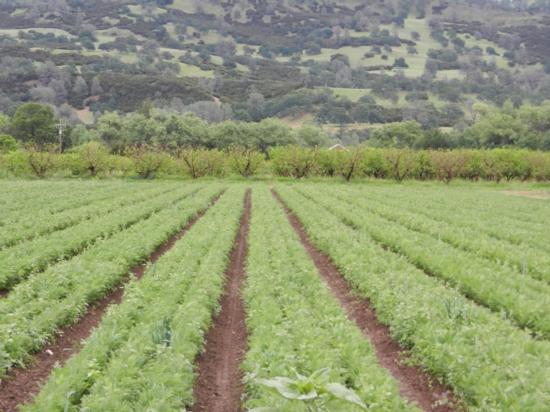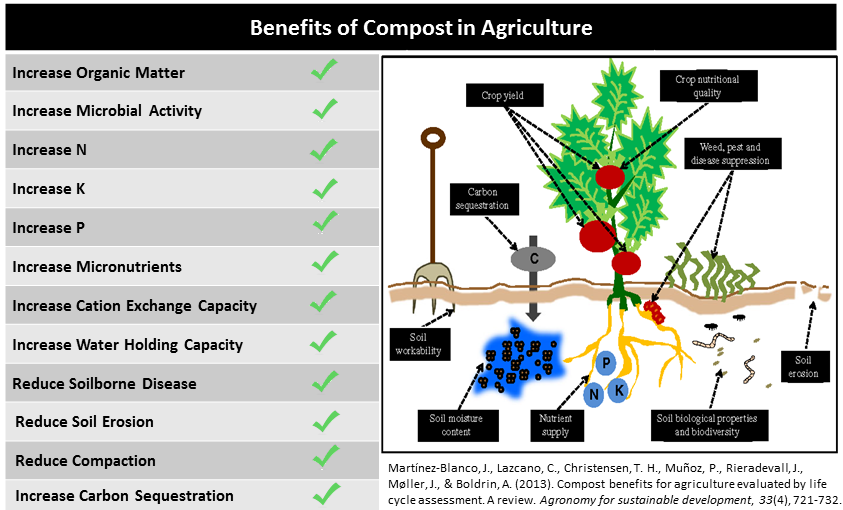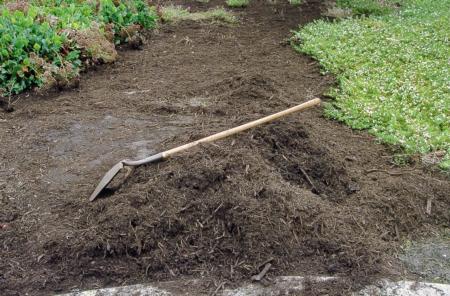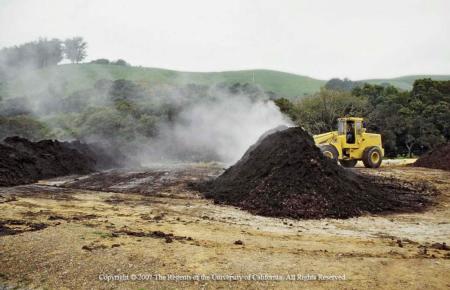Compost

What is compost?
Compost is defined as the product resulting from the controlled biological decomposition of organic material1. Compost production involves heat generation through microbial activity (mostly aerobic) that can eliminate pathogens and other harmful bacteria, as well as stabilize the product such that it is appropriate for application in agricultural soils. Composting is a process that can be applied to various raw organic materials including yard trimmings, kitchen scraps, and manure, to name a few. The materials used to produce compost (referred to as feedstocks), as well as the composting procedure and length of maturation determine the quality of the compost2.
What are the Benefits of Compost in Agriculture?

Increase Organic Matter
One of the greatest benefits of compost application in agricultural systems is the increase of soil organic matter that occurs. Organic matter is derived from the remains of decomposing plant, animal and waste material3. Increases in soil organic matter have been directly linked to increased water holding capacity, aggregate stability, and cation exchange capacity, to name a few2. These are discussed more in detail in later sections.
Increase Microbial Activity and Diversity
Increased microbial activity and diversity improves nutrient cycling in the soil, promotes disease suppression and improves soil structure4,5. Compost applications have been shown to increase both the microbial activity in the soil and the diversity of microorganisms6,7. The degree of increase depends on the type of compost, soil type, climate, C:N ratio and application rate8. However, only recently have studies begun to link this diversity to increases in soil organic matter stabilization9.
Increase Soil Macro- and Micronutrient Content
Nitrogen: The nitrogen added to the system via compost is mostly in the form of organic N which is not immediately available to plants. Soil microbes mineralize the organic N over time and convert it to ammonium and nitrate. In this way, compost can act as a slow release source of N to crops7. The amount of N that becomes available both in the short and mid to long term depends on the C:N ratio of the compost, soil type, climate as well as management practices2. It should be noted that although some N becomes available over time with compost applications, most compost does not exceed 2 percent nitrogen and is thus not considered to be a major source of nitrogen9. To learn more about the factors affecting the availability of nitrogen from compost read our resources on organic sources of nitrogen.
Phosphorus: Studies have found between 35 and 100 percent of total P in compost is released depending on the time elapsed after application (35% available after 1 year, 100% available after 3-5 years). Composts originating from manures have the highest amounts of P10,11.
Potassium: Compost applications can provide potassium to the cropping system. One recent study12 found that in tomatoes with low potassium (below 200ppm), composted poultry manure applications have resulted in higher yields. This study is supported by several others that have found compost applications to increase plant available potassium to the degree that it can replace fertilizer potassium 10,11,13,14.
Micronutrients: Compost can provide essential micronutrients that aren’t provided by mineral fertilizers. These micronutrients, while required in smaller quantities than the macronutrients, are equally as important for crop development. However the content of these micronutrients in compost varies widely depending on the original compost feedstock as well as the composting conditions15.
 Increase Cation Exchange Capacity
Increase Cation Exchange Capacity

An increase in cation exchange capacity promotes better retention of nutrients in the soil profile and can lead to improved fertilizer use efficiency16.
Increase Soil Water Retention
Compost applications have been shown to increase water holding capacity (WHC). The increase in WHC is often attributed to compost reducing the bulk density of the soil and increasing porosity2. While improved water holding capacity has been observed across a variety of soil types, the most dramatic improvements occur in sandy soils with low initial organic matter content17,18. In addition to improved water holding capacity, compost has been shown to reduce surface sealing, improve infiltration and reduce runoff13.
Suppress Soilborne Pathogens
Several studies have shown compost applications can effectively suppress soilborne disease, especially Pythium spp, Fusarium spp, Phytophthora spp and Verticillium dahlia5,19. Disease suppression in compost is primarily attributed to microbial activity and the enrichment of specific microbial species20. Important considerations are the type of compost, the composting process and the rate of application. The suppressive effect has been shown to increase with rate of compost, and compost inclusion of 10-20% (by volume of the root zone) is generally considered to be required to achieve disease suppression5,19. It should be noted that suppressive effects have been well-demonstrated under controlled conditions in the nursery and transplant industries, but less so under field conditions.
Improve Soil Stability and Workability
Compost applications have been shown to increase aggregate stability which makes the soil more resistant to erosion16,21. This effect is largely attributed to increased levels of organic matter in the soil which improves soil aggregation and structure2.
Soil workability depends on soil texture, soil organic matter content, soil structure and bulk density. A major challenge to soil workability is soil compaction which is directly related to reduced crop yield and quality, increased erosion and increased requirements for tillage. The ability of compost applications to increase soil organic matter and aggregate stability while reducing bulk density effectively reduces soil compaction7,21.
Increase Carbon Sequestration
Compost applications may be an effective strategy for storing carbon in the soil. Efficacy significantly depends on soil, climate, management practices (especially tillage) and the time frame considered7,14,22. Long term carbon sequestration may be most effective in no-till systems, and/or in soils with low soil organic matter that are well below their soil organic carbon saturation point7,11,23. Further research is needed to determine the degree and longevity of long-term carbon sequestration.
Effect on Nitrous Oxide Emissions
Results of studies on whether the application of compost increases or decreases N2O emissions have been inconsistent. This is largely due to the variability within and between soils, as well as the application rates and composition of compost24. It has been found that applying compost to wet soil in combination with ammonium-based fertilization increases N2O emissions significantly25. Meanwhile other studies have found that compost application results in significantly lower N2O emissions than urea fertilizer26, and can even mitigate emissions when applied in combination with feedlot manure27.
Environmental Concerns of Compost Application in Agriculture
Heavy Metals
Heavy metals are a major concern when it comes to the environmental and agronomic impacts of compost applications in agriculture. This concern is most relevant to applications of municipal solid waste compost, which is comprised primarily of kitchen scraps and yard trimmings. Several studies have recommended that municipal waste compost (MSW) be source separated, and to avoid compost that includes sewage sludge which often contains high levels of heavy metals2. The degree of heavy metal concentration in compost depends on the original feedstock as well as the compost maturity, with water-soluble fractions of heavy metals tending to decrease and stabilize after the thermophilic stage of composting28. An important consideration is the bioavailability of metals introduced through compost applications. There is a general consensus among research studies that aerobic composting processes increase the complexation (tying up) of heavy metals, which limits solubility and potential bioavailability for plant uptake and leaching2. Key factors that influence crop uptake and leaching of heavy metals from compost include: the chemical association between the metal and the organic residue/ soil matrix, the soil pH, the concentration of the metal, and the ability of the crop to regulate the uptake of the metal29.
Organic Pollutants

Accumulation of Salts
Studies have found that the electrical conductivity of compost (a measure of salts) is much higher than that of agricultural soils2. This has raised the concern that repeated applications of compost over the long term may cause an accumulation of salts, which could potentially inhibit seed germination34. It should be noted that increase in salt levels are proportional to application rates. Furthermore, salt levels typically decline over time with crop removal and leaching. Increased crop uptake of sodium in compost amended soils has been demonstrated in strawberries, spinach and timothy and red clover35,36,37.
References
1. Compost and Its Benefits. (2008). Retrieved February 9, 2016, from http://compostingcouncil.org/admin/wp-content/uploads/2010/09/Compost-and-Its-Benefits.pdf
2. Hargreaves, J. C., Adl, M. S., & Warman, P. R. (2008). A review of the use of composted municipal solid waste in agriculture. Agriculture, Ecosystems & Environment, 123(1), 1-14.
3. Cornell University Cooperative Extension. (2008). Cornell Fact Sheet 41. Retrieved February 9, 2016, from http://nmsp.cals.cornell.edu/publications/factsheets/factsheet41.pdf
4. Diacono, M., & Montemurro, F. (2010). Long-term effects of organic amendments on soil fertility. A review. Agronomy for sustainable development, 30(2), 401-422.
5. Bonanomi, G., Antignani, V., Pane, C., & Scala, F. (2007). Suppression of soilborne fungal diseases with organic amendments. Journal of Plant Pathology, 311-324.
6. Bastida, F., Kandeler, E., Moreno, J. L., Ros, M., García, C., & Hernández, T. (2008). Application of fresh and composted organic wastes modifies structure, size and activity of soil microbial community under semiarid climate. Applied Soil Ecology, 40(2), 318-329.
7. Martínez-Blanco, J., Lazcano, C., Christensen, T. H., Muñoz, P., Rieradevall, J., Møller, J., ... & Boldrin, A. (2013). Compost benefits for agriculture evaluated by life cycle assessment. A review. Agronomy for sustainable development, 33(4), 721-732.
8. Tiemann, L. K., Grandy, A. S., Atkinson, E. E., Marin-Spiotta, E., & McDaniel, M. D. (2015). Crop rotational diversity enhances belowground communities and functions in an agroecosystem. Ecology letters, 18(8), 761-771.
10. Amlinger, F., Götz, B., Dreher, P., Geszti, J., & Weissteiner, C. (2003). Nitrogen in biowaste and yard waste compost: dynamics of mobilisation and availability—a review. European Journal of Soil Biology, 39(3), 107-116.
11. Brown, S., & Cotton, M. (2011). Changes in soil properties and carbon content following compost application: results of on-farm sampling. Compost Science & Utilization, 19(2), 87-96.
12. Leacox, B., Davis, M., & Miyao, G. (2014). Evaluation of Composted Poultry Manure & Potassium as Plant Nutrient Supplements to Improve Tomato Plant Health. 2015 Northern San Joaquin Valley Processing Tomato Production Meeting.
13. ROU (2007) Life cycle inventory and life cycle assessment for windrow composting systems. NSW Department of Environment and Conservation. The University of New South Wales, Sydney, Australia.
14. Boldrin, A., Andersen, J. K., Møller, J., Favoino, E., & Christensen, T. H. (2009). Composting and compost utilization: accounting of greenhouse gases and global warming contributions. Waste Management & Research.
15. Favoino, E., & Hogg, D. (2008). The potential role of compost in reducing greenhouse gases. Waste Management & Research, 26(1), 61-69.
16. Diacono, M., & Montemurro, F. (2010). Long-term effects of organic amendments on soil fertility. A review. Agronomy for sustainable development, 30(2), 401-422.
17. Glab, T., Zaleski, T., Erhart, E., & Hartl, W. (2009). Effect of biowaste compost and nitrogen fertilization on water properties of Mollic-gleyic Fluvisol. International Agrophysics, 23(2), 123-128.
18. Khaleel, R., Reddy, K. R., & Overcash, M. R. (1981). Changes in soil physical properties due to organic waste applications: a review. Journal of Environmental Quality, 10(2), 133-141.
19. Noble, R., & Coventry, E. (2005). Suppression of soil-borne plant diseases with composts: a review. Biocontrol Science and Technology, 15(1), 3-20.
20. de Bertoldi, M. (2010). Production and utilization of suppressive compost: environmental, food and health benefits. In Microbes at Work (pp. 153-170). Springer Berlin Heidelberg.
21. Ruehlmann, J., & Körschens, M. (2009). Calculating the effect of soil organic matter concentration on soil bulk density. Soil Science Society of America Journal, 73(3), 876-885.
22. Stewart, C. E., Paustian, K., Conant, R. T., Plante, A. F., & Six, J. (2007). Soil carbon saturation: concept, evidence and evaluation. Biogeochemistry, 86(1), 19-31.
23. Sodhi, G. P. S., Beri, V., & Benbi, D. K. (2009). Soil aggregation and distribution of carbon and nitrogen in different fractions under long-term application of compost in rice–wheat system. Soil and Tillage Research, 103(2), 412-418.
24. Inubushi, K., Goyal, S., Sakamoto, K., Wada, Y., Yamakawa, K., & Arai, T. (2000). Influences of application of sewage sludge compost on N 2 O production in soils. Chemosphere-Global Change Science, 2(3), 329-334.
25. Zhu, X., Silva, L. C., Doane, T. A., Wu, N., & Horwath, W. R. (2013). Quantifying the effects of green waste compost application, water content and nitrogen fertilization on nitrous oxide emissions in 10 agricultural soils. Journal of environmental quality, 42(3), 912-918.
26. Alluvione, F., Bertora, C., Zavattaro, L., & Grignani, C. (2010). Nitrous oxide and carbon dioxide emissions following green manure and compost fertilization in corn. Soil Science Society of America Journal, 74(2), 384-395.
27. Dalal, R. C., Gibson, I., Allen, D. E., & Menzies, N. W. (2010). Green waste compost reduces nitrous oxide emissions from feedlot manure applied to soil. Agriculture, ecosystems & environment, 136(3), 273-281.
28. Leita, L., & De Nobili, M. (1991). Water-soluble fractions of heavy metals during composting of municipal solid waste. Journal of Environmental Quality, 20(1), 73-78.
29. Smith, S. R. (2009). A critical review of the bioavailability and impacts of heavy metals in municipal solid waste composts compared to sewage sludge. Environment international, 35(1), 142-156.
30. Lashermes, G., Houot, S., & Barriuso, E. (2010). Sorption and mineralization of organic pollutants during different stages of composting. Chemosphere, 79(4), 455-462.
31. Liang, C., Das, K. C., & McClendon, R. W. (2003). The influence of temperature and moisture contents regimes on the aerobic microbial activity of a biosolids composting blend. Bioresource Technology, 86(2), 131-137.
32. Haudin, C. S., Zhang, Y., Dumény, V., Lashermes, G., Bergheaud, V., Barriuso, E., & Houot, S. (2013). Fate of 14 C-organic pollutant residues in composted sludge after application to soil. Chemosphere, 92(10), 1280-1285.
33. Logan, T. J., Henry, C. L., Schnoor, J. L., Overcash, M., & McAvoy, D. C. (1999). An assessment of health and environmental risks of trace elements and toxic organics in land-applied municipal solid waste compost. Compost Science & Utilization, 7(3), 38-53.
34. He, X. T., Logan, T. J., & Traina, S. J. (1995). Physical and chemical characteristics of selected US municipal solid waste composts. Journal of Environmental Quality, 24(3), 543-552.
35. Shanmugam, G. S., & Warman, P. R. (2004). Soil and plant response to organic amendments to three strawberry cultivars. Proceedings of the International Humic Substances Society. Embrapa (Pub.), Sao Pedro, 230-232.
36. Zheljazkov, V. D., Astatkie, T., Caldwell, C. D., MacLeod, J., & Grimmett, M. (2006). Compost, manure, and gypsum application to timothy/red clover forage. Journal of environmental quality, 35(6), 2410-2418.
37. Maftoun, M., Moshiri, F., Karimian, N., & Ronaghi, A. M. (2005). Effects of two organic wastes in combination with phosphorus on growth and chemical composition of spinach and soil properties. Journal of plant nutrition, 27(9), 1635-1651.
